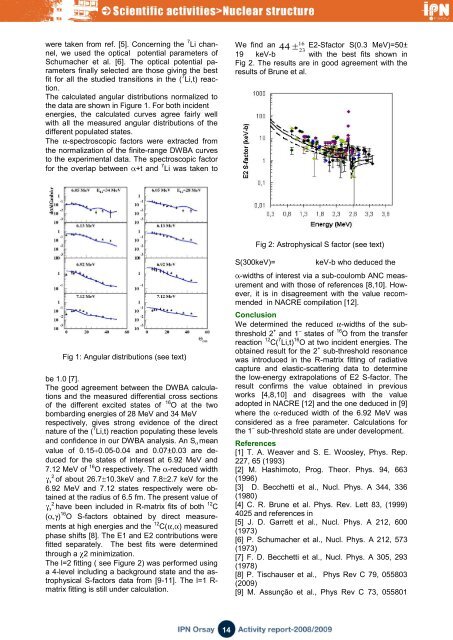exotic nuclei structure and reaction noyaux exotiques ... - IPN - IN2P3
exotic nuclei structure and reaction noyaux exotiques ... - IPN - IN2P3
exotic nuclei structure and reaction noyaux exotiques ... - IPN - IN2P3
You also want an ePaper? Increase the reach of your titles
YUMPU automatically turns print PDFs into web optimized ePapers that Google loves.
were taken from ref. [5]. Concerning the 7 Li channel,<br />
we used the optical potential parameters of<br />
Schumacher et al. [6]. The optical potential parameters<br />
finally selected are those giving the best<br />
fit for all the studied transitions in the ( 7 Li,t) <strong>reaction</strong>.<br />
The calculated angular distributions normalized to<br />
the data are shown in Figure 1. For both incident<br />
energies, the calculated curves agree fairly well<br />
with all the measured angular distributions of the<br />
different populated states.<br />
The -spectroscopic factors were extracted from<br />
the normalization of the finite-range DWBA curves<br />
to the experimental data. The spectroscopic factor<br />
for the overlap between +t <strong>and</strong> 7 Li was taken to<br />
We find an 16<br />
44 E2-Sfactor S(0.3 MeV)=50<br />
23<br />
19 keV-b with the best fits shown in<br />
Fig 2. The results are in good agreement with the<br />
results of Brune et al.<br />
Fig 2: Astrophysical S factor (see text)<br />
Fig 1: Angular distributions (see text)<br />
be 1.0 [7].<br />
The good agreement between the DWBA calculations<br />
<strong>and</strong> the measured differential cross sections<br />
of the different excited states of 16 O at the two<br />
bombarding energies of 28 MeV <strong>and</strong> 34 MeV<br />
respectively, gives strong evidence of the direct<br />
nature of the ( 7 Li,t) <strong>reaction</strong> populating these levels<br />
<strong>and</strong> confidence in our DWBA analysis. An S mean<br />
value of 0.15 0.05-0.04 <strong>and</strong> 0.07 0.03 are deduced<br />
for the states of interest at 6.92 MeV <strong>and</strong><br />
7.12 MeV of 16 O respectively. The -reduced width<br />
2<br />
of about 26.7 10.3keV <strong>and</strong> 7.8 2.7 keV for the<br />
6.92 MeV <strong>and</strong> 7.12 states respectively were obtained<br />
at the radius of 6.5 fm. The present value of<br />
2<br />
have been included in R-matrix fits of both 12 C<br />
( , ) 16 O S-factors obtained by direct measurements<br />
at high energies <strong>and</strong> the 12 C( , ) measured<br />
phase shifts [8]. The E1 <strong>and</strong> E2 contributions were<br />
fitted separately. The best fits were determined<br />
through a 2 minimization.<br />
The l=2 fitting ( see Figure 2) was performed using<br />
a 4-level including a background state <strong>and</strong> the astrophysical<br />
S-factors data from [9-11]. The l=1 R-<br />
matrix fitting is still under calculation.<br />
S(300keV)=<br />
keV-b who deduced the<br />
-widths of interest via a sub-coulomb ANC measurement<br />
<strong>and</strong> with those of references [8,10]. However,<br />
it is in disagreement with the value recommended<br />
in NACRE compilation [12].<br />
Conclusion<br />
We determined the reduced -widths of the subthreshold<br />
2 + <strong>and</strong> 1 – states of 16 O from the transfer<br />
<strong>reaction</strong> 12 C( 7 Li,t) 16 O at two incident energies. The<br />
obtained result for the 2 + sub-threshold resonance<br />
was introduced in the R-matrix fitting of radiative<br />
capture <strong>and</strong> elastic-scattering data to determine<br />
the low-energy extrapolations of E2 S-factor. The<br />
result confirms the value obtained in previous<br />
works [4,8,10] <strong>and</strong> disagrees with the value<br />
adopted in NACRE [12] <strong>and</strong> the one deduced in [9]<br />
where the -reduced width of the 6.92 MeV was<br />
considered as a free parameter. Calculations for<br />
the 1 – sub-threshold state are under development.<br />
References<br />
[1] T. A. Weaver <strong>and</strong> S. E. Woosley, Phys. Rep.<br />
227, 65 (1993)<br />
[2] M. Hashimoto, Prog. Theor. Phys. 94, 663<br />
(1996)<br />
[3] D. Becchetti et al., Nucl. Phys. A 344, 336<br />
(1980)<br />
[4] C. R. Brune et al. Phys. Rev. Lett 83, (1999)<br />
4025 <strong>and</strong> references in<br />
[5] J. D. Garrett et al., Nucl. Phys. A 212, 600<br />
(1973)<br />
[6] P. Schumacher et al., Nucl. Phys. A 212, 573<br />
(1973)<br />
[7] F. D. Becchetti et al., Nucl. Phys. A 305, 293<br />
(1978)<br />
[8] P. Tischauser et al., Phys Rev C 79, 055803<br />
(2009)<br />
[9] M. Assunção et al., Phys Rev C 73, 055801<br />
14

















